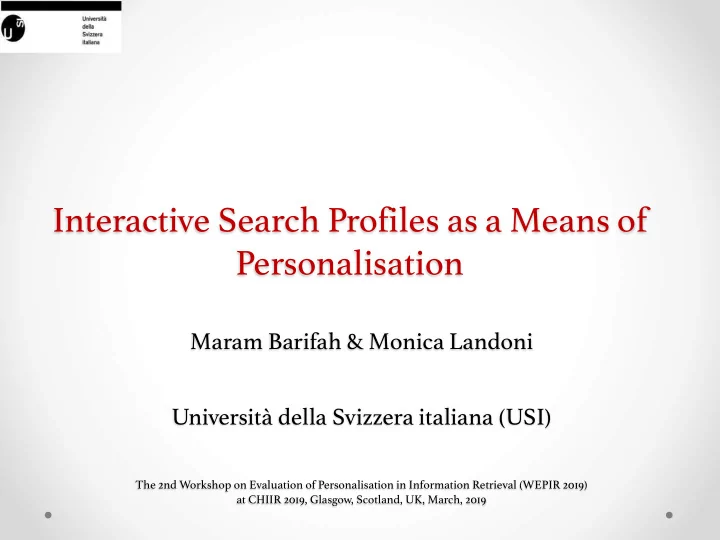

Interactive Search Profiles as a Means of Personalisation Maram Barifah & Monica Landoni Università della Svizzera italiana (USI) The 2nd Workshop on Evaluation of Personalisation in Information Retrieval (WEPIR 2019) at CHIIR 2019, Glasgow, Scotland, UK, March, 2019
Motivation • DLs, as information provider platforms, service heterogeneous users and facilitate knowledge acquisition among users. Users tend to visit DL to fulfill their information needs (IN) • INs are addressed by the available contents and affected by the interface design, familiarity and expertise of the users. • Considering user interactions in the user profiling will produce more reliable users’ representations.
Motivation We are: • Exploring existing interactions by investigating the log files (LF) • Proposing ISPs as a means for personalisation
RERO Doc • It is a Swiss digital library • The library offers free access to its contents and services. The login is an option • The geographical locations of the users are world-wide • Different items ranging from books and articles to photographs and sound recordings are available.
RERO Doc: http://doc.rero.ch
RERO Doc result page 5
More Functions Searchers also can sort the search search in fulltext or save the the • • results selected filter for next search Searchers also have the options to look • at similar records, field, or institute 6
Dataset • The dataset contains the entries of eight-months records from (May 2017-January 2018) with more than 6 M sessions consisting of 24M records of 20 GB • The long period covers different seasons i.e. before and after exams, annual holidays, and during the semesters 7
The Framework of Exploring UPs in LFs Interface Analysis Data Preparation Building action typology Data Sampling Analytical techniques selection Features Examination Patterns Extraction Patterns Interpretation M Barifah, M Landoni : A Framework for Exploring Usage Pattern in Digital Libraries , JCDL 2019, Illinois, USA 8
Usage Patterns (UP)s: Searchers (S) Item Seekers (IS) Navigators (N) Known item S (KS) Simple S (SS) Satisfied IS (SIS) Light N (LN) Average S (AS) Multivio IS (MIS) Average N (AN) Familiar average S (FAS) Average IS (AIS) Advance N (DN) Advance S (DS) Advance IS (DIS) Press N (PN) Familiar advance S (FDS) Sophisticated S (PS) 9
ISPs: A. Data-driven profiles that depict the types of interaction a segment of users performs with the system B. Real representations of the users interaction (new and existing users) C. A tool can be used by designers for re-evaluation or redesign the interface. 11
ISPs 12
Personalization and Design Implementation: Interface personalization: Promoting different search strategies: • Visualising the search results by applying external thesauri and suggested terms through machine learning techniques. ( Cao et al, 2010, Hajra & Tochtermann, 2018) Providing auto completion function, or ”Popular Terms” function. This • might accelerate the searching time for the struggling users. (Kay, 2019) • Better utilisation of the filter and sort functions ( Niu and Hemminger ) Improving navigation experiences: Providing RERO Doc with navigation icons , Icons are preferable to abstract text as they are easier to memories ( Rahrovani, 2017). 13
Example of an ISP: Known item Searcher: • This pattern represents users who usually spend 60 seconds as a maximum duration, search by simple search function, and use the author and keyword facets. Their search usually ends with viewing results page. Out of this pattern, a further ISPs can be constructed with different scenarios e.g.: Are KS aware of the facets functionality? • What are the different paths/ tactics might be suggested? • What are the tools that might help KS? • 14
Conclusion LF analysis reveals valuable information about the user interaction and • their preferences. Considering the interaction might present more reliable users’ • representations ISPs serve as an input into the redesign and refinement of the interface, and • in general of the functionality of the system. ISPs serve the need of iterative evaluations , accounting for new users • coming. 15
Future works: A user study will be conducted to validate the LF findings. • Expert study involving experts in DL design and development. • 16
Thank you Questions? 17
References 1. Cao, N., Sun, J., Lin, Y.R., Gotz, D., Liu, S., Qu, H.: Facetatlas: Multifaceted vi- sualization for rich text corpora. IEEE transactions on visualization and computer graphics (2010) 1. Hajra, A., Tochtermann, K.: Visual search in digital libraries and the usage of external terms. In: 2018 22nd International Conference Information Visualisation (IV) (2018) 2. Kay, J.: Improving access to e-resources for users at the university of derby: enhancing discovery systems with library plus 2.0. Insights (2019) 3. Matusiak, K.K.: User navigation in large-scale distributed digital libraries: The case of the digital public library of america. Journal of Web Librarianship (2017) 4. Rahrovani, S., Mirzabeigi, M., Abbaspour, J.: The trained and untrained users’ mental models compatibility with the icons of search modules in iranian digital library applications. Library Hi Tech (2017) 18
Recommend
More recommend